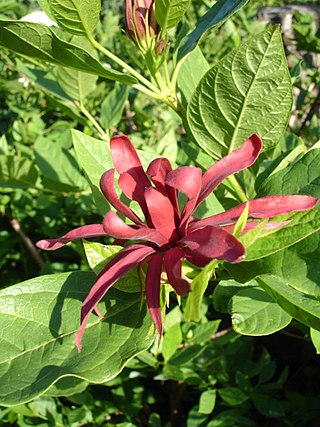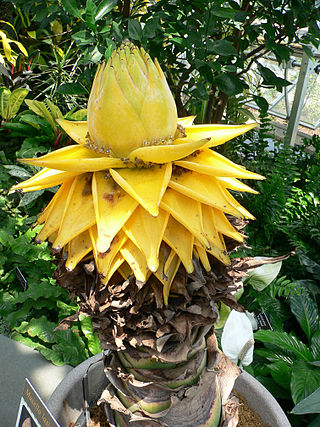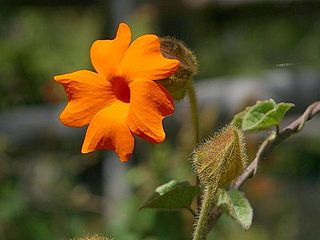
Magnolia is a large genus of about 210 to 340 flowering plant species in the subfamily Magnolioideae of the family Magnoliaceae. It is named after French botanist Pierre Magnol.

Acanthaceae is a family of dicotyledonous flowering plants containing almost 250 genera and about 2500 species. Most are tropical herbs, shrubs, or twining vines; some are epiphytes. Only a few species are distributed in temperate regions. The four main centres of distribution are Indonesia and Malaysia, Africa, Brazil, and Central America. Representatives of the family can be found in nearly every habitat, including dense or open forests, scrublands, wet fields and valleys, sea coast and marine areas, swamps, and mangrove forests.

Daphne is a genus of between 70 and 95 species of deciduous and evergreen shrubs in the family Thymelaeaceae, native to Asia, Europe and north Africa. They are noted for their scented flowers and often brightly coloured berries. Two species are used to make paper. Many species are grown in gardens as ornamental plants; the smaller species are often used in rock gardens. All parts of daphnes are poisonous, especially the berries.

Strobilanthes is a genus of about 350 species of flowering plants in the family Acanthaceae, mostly native to tropical Asia and Madagascar, but with a few species extending north into temperate regions of Asia. Many species are cultivated for their two-lipped, hooded flowers in shades of blue, pink, white and purple. Most are frost-tender and require protection in frost-prone areas.

Calycanthus, called sweetshrub, is a genus of flowering plants in the family Calycanthaceae. The genus includes two to four species depending on taxonomic interpretation; three are accepted by most 21st century sources.

Ulmus lamellosa, commonly called the Hebei elm, is a small deciduous tree native to four Chinese provinces, Hebei, Henan, Nei Mongol, and Shanxi, to the west and south of Beijing.

Ligustrum lucidum, the broad-leaf privet, Chinese privetglossy privet, tree privet or wax-leaf privet, is a species of flowering plant in the olive family Oleaceae, native to the southern half of China and naturalized in many places. The name "Chinese privet" is also used for Ligustrum sinense.

Musella lasiocarpa, commonly known as Chinese dwarf banana, golden lotus banana or Chinese yellow banana, is the sole species in the genus Musella. It is thus a close relative of bananas, and also a member of the family Musaceae. The plant is native to the Yunnan province in China, where it grows high in the mountains up to an altitude of 2500 m. It is known for its erect, yellow pseudostems, generally appearing during the second year of cultivation, that can last a few months. Just before opening, the yellow, flower-like pseudostem resembles a lotus - from which the plant gets one of its names.

Symphyotrichum lateriflorum is a species of flowering plant in the aster family (Asteraceae). Commonly known as calico aster, starved aster, and white woodland aster, it is native to eastern and central North America. It is a perennial and herbaceous plant that may reach heights up to 120 centimeters and widths up to 30 centimeters.

Sir Arthur William Hill was Director of the Royal Botanic Gardens, Kew, and a noted botanist and taxonomist.

Barleria prionitis is a shrub in the family Acanthaceae, native to Island and Mainland Southeast Asia, China, the Indian Subcontinent, the Arabian Peninsula and northeastern Africa. It is widely spread as an ornamental and weed, occurring in naturalised populations around the world. It used not only as an ornamental but also as a hedge and extensively as a component of folk medicines. As a weed it is regarded as problematic in many areas.
Brian Frederick Mathew MBE, VMH is a British botanist, born in the village of Limpsfield, Surrey, England. His particular area of expertise is bulbous plants, particularly ornamental bulbous plants, although he has contributed to other fields of taxonomy and horticulture. He has authored or co-authored many books on bulbs and bulbous genera which appeal to both botanists and gardeners, as well as specialist monographs on other genera, including Daphne, Lewisia, and Helleborus. His work has been recognized by the British Royal Horticultural Society and the International Bulb Society.

Thunbergia gregorii, commonly known as orange clockvine or orange trumpet vine, is a herbaceous perennial climbing plant species in the family Acanthaceae, native to East Africa and sometimes cultivated as an ornamental vine. The bright, pure all-orange flowers distinguish it from the related black-eyed Susan vine.
Thomas Franklin Daniel is an American botanist, and teacher. He is a specialist of the botanical family Acanthaceae. In 1975 he obtained his undergraduate from Duke University. In 1980, he obtained his doctorate at the University of Michigan. In 1981, he was assistant professor. Between 1981 and 1985 he was an assistant curator of the Arizona State University Herbarium.
Atulananda Das (1879–1952) was an Indian botanist and forester noted for working for the Assam region of the Indian Forestry Service and describing species in the families Ericaceae, Ebenaceae, Dipterocarpaceae, Myrtaceae, Euphorbiaceae, Helwingiaceae, Flacourtiaceae, Lauraceae, Acanthaceae, Fagaceae, and Symplocaceae. In 1935 he was elected a Fellow of the Linnean Society of London.

Lachenalia ensifolia is a species of flowering plant in the genus Lachenalia, native to the Cape Provinces of South Africa. Its nominate subspecies Lachenalia ensifolia subsp. ensifolia has gained the Royal Horticultural Society's Award of Garden Merit.

Lachenalia viridiflora, commonly known as the green-flowered Cape cowslip or turquoise hyacinth, is a species of flowering plant in the asparagus family native to the southwest Cape Provinces of South Africa. It was discovered in the 1960s, and first described in 1972 by Winsome Fanny Barker.

Mackaya bella, called the forest bell bush, is a species of flowering plant in the acanthus family Acanthaceae, native to South Africa.

Magnolia laevifolia is a species of flowering plant in the family Magnoliaceae, native to south-central China. Hardy to USDA zone 8, it easily tolerates pruning, and can be formed into topiaries, hedges and screens. The Royal Horticultural Society recommends the 'Gail's Favourite' cultivar for small gardens.
Magnolia fulva is a species of flowering plant in the family Magnoliaceae, native to south-central China and Vietnam. It was first described, as Michelia fulva, in 1987.
















